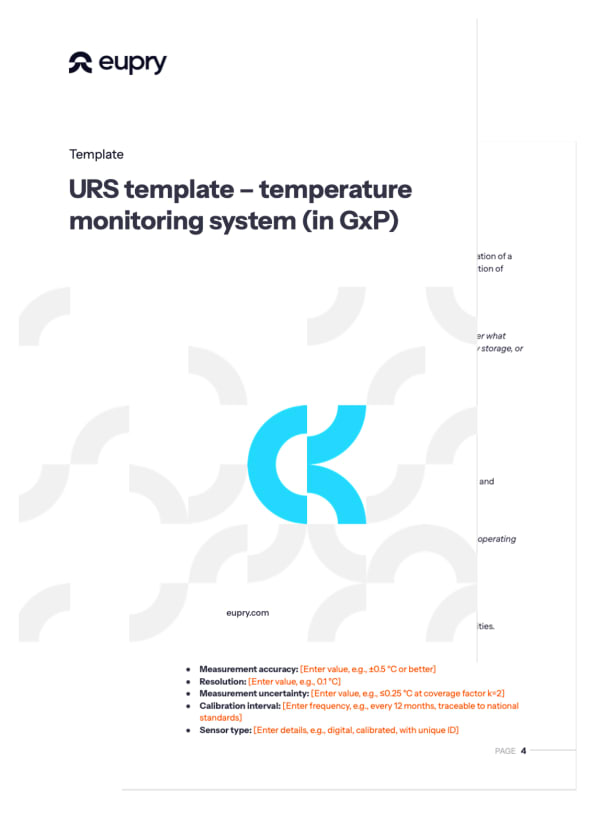Complete guide to URS development for temperature compliance
What it is, why it matters, and how to design one

Adam Hartmann-Kruckow
Understand what URS development in temperature compliance covers, why it matters, and how to develop one that meets GxP requirements.
Get a structured starting point aligned with WHO and ISPE to help you design your URS for mapping and monitoring solutions.

Author: Adam Hartmann-Kruckow, Co-founder of Eupry
What is a URS in temperature compliance?
A User Requirement Specification (URS) is the foundation of quality assurance in temperature‑controlled GxP environments.
A URS in temperature compliance is a formal document that defines the performance, compliance, and operational requirements for systems that control or monitor temperature‑sensitive products.
This includes temperature monitoring systems, temperature mapping equipment and services, and in some cases, calibration equipment and processes.
The URS serves as a blueprint for both internal teams and suppliers, ensuring everyone works from the same clear set of expectations. Importantly, a URS is not static. It is a living document that should evolve as your operations, risks, and regulatory requirements change.
Also read: How to write a URS for pharmaceutical storage areas and TCUs
When do you make a URS?
Drafting a URS is often part of the early stages of a procurement or commisioning process. Here, teams define the functional, compliance, and performance requirements up front so both procurement and suppliers know exactly what is needed.
Tip! In many real cases, the URS is not created this early in the process, but it is often a big advantage to do so. It is about locking in requirements early, in a way that is defensible during audits and adaptable as facilities, operations, or regulations change. If you know what you need from the beginning, there is a much greater chance that you will end up it in the end.
Also read: Guide: How to create a URS for temperature monitoring in GxP
Why URSs are important in regulated temperature control
In GxP industries, a URS ensures that systems and services:
- Meet WHO, ISPE, GDP, and GMP guidelines
- Maintain product quality and integrity across the cold chain
- Provide a clear benchmark for evaluating suppliers
- Stand up to regulatory inspection and audits
A well‑written URS saves time in procurement, prevents costly retrofits, and reduces the risk of non‑compliance.
Challenges in URS design
Developing a URS in GxP is not just about listing requirements; it is about balancing a handful of very common challenges such as:
- Detail vs. flexibility: Too vague and it is not useful; too rigid and it locks you into outdated processes.
- Audit readiness vs. operational efficiency: Meeting compliance without over‑engineering.
- Future‑proofing: Aligning with evolving WHO and ISPE guidelines and anticipating operational changes.
5 general guidelines for URS design
When developing a URS in thermal compliance the best results come from involving different (cross‑functional) teams to capture all operational and regulatory requirements for your specific operation. In other words, there is no size fits all in URS design.
However, there are general best practices that apply to most use cases.
For instance, consider the following advice:
- Make requirements measurable and unambiguous.
- Base the scope on risk — more detail for high‑risk areas, less detail for low‑risk.
- Reference specific regulations or guidelines for each requirement.
- Involve Quality, Validation, Engineering, and IT early in the process.
- Build in flexibility to accommodate future technology or process changes.
Monitoring URS overview
A monitoring URS defines requirements for systems that track and record temperatures continuously.
It typically covers areas such as:
- Sensor accuracy and uncertainty
- Data integrity and 21 CFR Part 11 compliance
- Alarm thresholds and escalation rules
- Integration with existing systems
- Calibration and maintenance intervals
Read the full guide: URS for temperature monitoring in GxP

Download a free URS template for temperature monitoring systems
Get an easy‑to‑use URS template designed for GxP to save time and ensure nothing is missed in your monitoring system requirements.
Mapping URS overview
A temperature mapping URS defines requirements for both the equipment used in mapping and the services that perform the studies.
It most often includes:
- Logger specifications (accuracy, calibration, battery life)
- Placement flexibility and scalability
- Mapping duration, seasonal conditions, and operational scenarios
- Documentation and reporting requirements
- Qualifications of service providers
Read the full guide: How to create a URS for temperature mapping in GxP

Get your free URS template for mapping equipment and services
Download a ready‑to‑use template to make creating a reliable, GxP‑compliant mapping URS faster — ensuring audit readiness, supplier clarity, and no missed requirements.
What are the typical mistakes often made in URS development
and how do you avoid them?
Many organizations make similar errors when drafting a URS, often because they underestimate how much detail and foresight is required.
Some common pitfalls of URS development are:
- Copy‑pasting a generic template without tailoring to your operations
- Omitting critical parameters such as measurement uncertainty
- Overcomplicating with unnecessary technical detail that adds cost without value
- Neglecting integration or lifecycle support requirements, which can create issues down the line
- Failing to align URS updates with change control processes, leading to compliance gaps

What do WHO, ISPE, and other regulatory bodies say?
Regulatory bodies offer clear expectations that should guide your URS development:
- WHO GDP: Requires validated temperature control processes and documented acceptance criteria.
- EU GMP Annex 15: Emphasises qualification, validation, and documented evidence to support compliance.
- ISPE Guidance: Offers best practices for mapping and monitoring, including risk‑based sensor placement and setting clear acceptance criteria.
These sources provide the compliance framework, while your actual URS makes it actionable and specific to your organization’s operations.
Quick view: Mini URS checklist (core clauses)
While each URS will be unique, most should cover the following:
- Scope and objectives: Clearly define what is covered and why.
- Applicable regulatory references: Specify the exact standards and guidelines.
- Technical or service requirements: Outline measurable performance or service levels.
- Data integrity and security requirements: Detail controls for secure, compliant data handling.
- Integration and maintenance expectations: Describe how systems will connect and be supported over their lifecycle.
Next steps
Now, you understand the basics of URS development in temperature compliance related fields – so what is next?
The short answer is that, if your primary concern is:
- Continuous monitoring: You can download a URS for temperature monitoring template
- Facility validation and mapping: You can download a URS for temperature mapping template
- Building or purchasing a storage area or TCU: You can read all about developing URSs for pharmaceutical storage areas and TCUs
- If you have questions or concerns, you are also more than welcome to book a free consultancy with one of our specialists right here.
FAQ: URS development for temperature compliance
Temperature monitoring systems
What should YOUR monitoring system include?
A well‑written URS is the best route to ensure you choose the right system for you. This template provides a structured starting point aligned with WHO and ISPE to help you design your URS and capture all relevant requirements to ensure consistent, audit‑ready monitoring of all environments.

Temperature mapping equipment and services in GxP
Define the right mapping solution for YOUR operation
Make the URS design process faster and more reliable with our URS template for temperature mapping in GxP, including separate sections for equipment and services, example clauses, and regulatory references.
